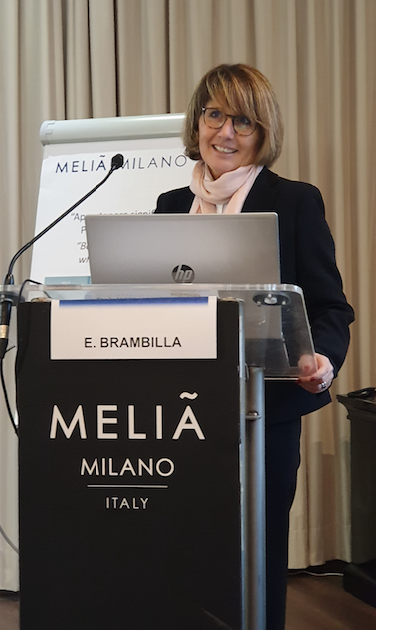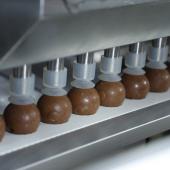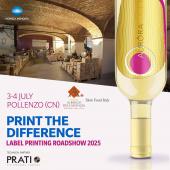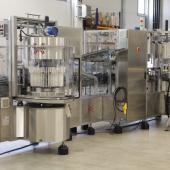The Italy of self-adhesive labels: fourth in Europe
Market data, environmental policies and technological trends seen at Labelexpo. This and more at the annual Gipea conference, which also this year registered a high turnout of associated labeling companies. Cristina Rossi
2018 growing, albeit at a low rate. The performance of large and medium-sized companies is good. The financial solidity of the sector is confirmed and there is a new peak in investments, with a positive correlation between investment capacity, growth and margins. This is, in a nutshell, the result of the eighth edition of the Economic Observatory, presented by Gianluca Cinti of Partners SpA last November 15th at the Hotel Melia in Milan during the technical conference of Gipea (Italian group producing self-adhesive labels that operates within Assografici).

2018: the overall picture
The sample analyzed in the Observatory is 88 companies, with revenues from 220 thousand to almost 75 million euros, which have a total turnover of 714 million euros in 2018.
The 19 companies with revenues exceeding 10 million represent more than half of the sample’s turnover. If we add to them the 32 companies with revenues between 5 and 10 million euros, we exceed 80% of the turnover of the sample.
If we then compare the Gipea data with the Finat data - the European association of adhesive label manufacturers - we see that in Italy there is a greater concentration of medium-to small companies: in the Belpaese, 56% of companies bill from 3 to 10 million euro, compared to 29% in Europe in the same turnover range.
In terms of geographical location, 76% of the companies in the sample are concentrated in 5 Italian regions: Lombardy (25%), Emilia Romagna (15%), Veneto (14%), Piedmont (11%) and Tuscany (6%).
According to the data emerged from a Eurostat survey prepared by the Centro Studi Assografici (which involves all companies with at least 20 employees and a sample of companies with a number of employees between 3 and 19), in 2018 Italian producers of self-adhesive labels have moderate growth compared to 2017, rising from 742 to 752 million euros.
Imports grew by 5.9% to around 76 million, while exports increased by 4%, from 120 to 124 million euros, equal to 16% of production.
Again based on the Eurostat survey, Italy is confirmed as the fourth largest market in Europe after Germany, Great Britain and France, with growth (1.4%) in line with the overall European average.
The Finat data show a certain vivacity in the observed period (2013-2018) in the annual growth in all European areas.
However, 2018 is characterized by the lowest growth rate starting from 2013 and this is also true for Southern Europe (which includes Italy), where revenue growth was 3.9% compared to 7.3% of 2017.
This result is attributable to the European context characterized by a scenario of economic uncertainty affecting the industry, a reduction in exports, an increase in unemployment and a decline in domestic demand (17%).
2019: the market accelerates and diversifies
A Gipea survey of a sample of 34 label companies confirms growth also in 2019, with a new acceleration. In particular, there was a 6.7% increase in the turnover of labels in the first 9 months of 2019 (271 million euros compared to 252 in 2018) and the most sustained development will affect larger companies, while smaller ones, with a turnover between 1 and 5 million euros, they show a decrease.
 As regards the diversification in progress in the sector, the Finat data indicate that the markets in which the associates are currently more active are self-adhesive labels (95%), flexible packaging (35%), sleeve labels (32%), non shrink-wrap tubular labels (27%), non-adhesive labels (16%), labels without liner (8%), pouches (8%), in mold labels (5%) and folding cartons (0%).
As regards the diversification in progress in the sector, the Finat data indicate that the markets in which the associates are currently more active are self-adhesive labels (95%), flexible packaging (35%), sleeve labels (32%), non shrink-wrap tubular labels (27%), non-adhesive labels (16%), labels without liner (8%), pouches (8%), in mold labels (5%) and folding cartons (0%).
In which markets, instead, are Finat converters planning to enter?
On top the pouches (20%), followed by labels without liner (17%), in mold labels (17%), flexible packaging (14%), tubular non-shrinkable labels (14%), sleeve labels (6%), folding cartons (6%) and non-adhesive labels (3%).
According to a Gipea survey of 7 suppliers of self-adhesive materials, which represent about 95% of the deliveries made to Italian labeling companies, purchases of self-adhesive materials confirm the increase in volumes (+ 2.2% in 2018).
However, it should be noted that growth does not affect everyone: in 2018 there are as many as 38 companies with declining revenues and 24 companies with revenues lower than 2008. The incidence of exports is in line with Eurostat data and the main exporters are the largest companies: 70% of foreign revenues are obtained from 4 companies.
Despite the predominantly domestic turnover, since 2008 the label producers have grown more than many other sectors, thus also consolidating the volume of investments, as shown by the numbers: companies with a high propensity to invest stand at 22, or more than 10%, those with an average propensity are 49 and there are just 17 companies with a low propensity to invest.
Still on the subject, a curious fact comes from the Finat forecasts: in 2019 and 2020 investments in conventional machines will exceed those in digital machines.
In conclusion
The sector appears to have entered a more mature phase in its life cycle and consolidation. Growth was contained in 2018 and 38 companies reported declining revenues.
Margins are positive and slightly recovering, the number of loss-making companies is growing, there is a positive correlation between investment capacity, growth and margins, the return on invested capital is down and there is a continuous polymerization of performance.
|
GIPEA: VOCI DI GRUPPO • The president Elisabetta Brambilla opened the proceedings of the Gipea technical conference illustrating the initiatives in progress, which include an ambitious plan of communication and services to the associates, activities on social media, training, the census of the sector and relations with the academic world. -  The communication plan, launched in 2019, provides for activities towards members (provision of primary consultancy to members and organization of meetings and events), communication activities (promotion of Gipea to potential new members through the renewed website and use of social networks) and training activities (course program). The communication plan, launched in 2019, provides for activities towards members (provision of primary consultancy to members and organization of meetings and events), communication activities (promotion of Gipea to potential new members through the renewed website and use of social networks) and training activities (course program).«At the level of training we are trying to intercept the needs of companies, but we await the suggestions of everyone” declared Brambilla addressing the audience». Three the proposals already planned: a prepress and file management course (5 February 2020, held by Ester Crisanti and Giovanni Daprà), the course “Labels in contact with food” (26 February, with Italo Vailati) and a course on budgeting and cost analysis (19 and March 20, held by Studio Partners. «We are also carrying out a census of label producers in Italy, and at the moment - Brambilla explained - we have recovered the information of over 500 companies. Updating the database will also be useful for developing a new associative marketing strategy, involving an increasing number of companies so as to increase representativeness and grow the culture of the sector. In terms of relations with the academic world, we will collaborate with the Turin Polytechnic, which has launched a new master’s degree: in addition to sponsoring a thesis on the topic of self-adhesive labels, we are committed to offering internships to students and, if required, we will provide lectures, seminars and testimony to the Politecnico in the context of educational activities “. -  • Italo Vailati (the Gipea secretary) spoke about plastic strategy and circular economy, recalling that in Europe, 84 million tons of packaging are produced per year, of which a quarter in plastic. The first document on the “plastic strategy” was published in January 2018; in June 2018 the packaging waste directive was modified with new targets and in January 2011 the directive 904/2019 SUP (Single Use Plastic) was published, which member states will have to implement by 2021. • Italo Vailati (the Gipea secretary) spoke about plastic strategy and circular economy, recalling that in Europe, 84 million tons of packaging are produced per year, of which a quarter in plastic. The first document on the “plastic strategy” was published in January 2018; in June 2018 the packaging waste directive was modified with new targets and in January 2011 the directive 904/2019 SUP (Single Use Plastic) was published, which member states will have to implement by 2021.According to the “plastic strategy”, by 2030 the plastic products marketed in the European community will have to be reusable or they will have to be recycled cheaply. More than half of the plastic waste generated in Europe will have to be recycled; separate collection of plastics can reach high levels of efficiency thanks to adequate collection systems, a reduction in waste generation and above all an increase in consumer awareness, called to avoid dispersing them into the environment. -- • Giovanni Daprà and Mara Baschieri provided an update on the digital and social activities of Gipea (site restructuring and creation of the Linkedin profile), on which the group is aiming with conviction. - • The morning ended with interventions by Anna Perego and Piero Pozzi from Colorgraf on compostable inks and Alberto Quaglia from Gipea on news and limitations of thermal papers. - Impressions from Labelexpo Europe • The complexity in the world of labels is increasing exponentially and this makes it more difficult to keep everything under control. Michele Libori of Gipea, charged with the task of reporting on the news of the recent Labelexpo Europe is convinced of this. «First of all, to deal with complexity we can no longer consider just the label, but have to consider the packaging as a whole» he said, emphasizing the need to find, however, even among customers, competent interlocutors so as to avoid becoming a scapegoat for results not meeting expectations. Getting information is therefore a must. «At Labelexpo we have seen changes on all fronts. Graphic designers, creatives, prepress and printing operators must keep up to date not only on how to obtain an attractive product, but also on international or local standards». From a comparison with the 2017 edition, the lesser propensity of the brand owners to identify a print-only company emerged: in fact, the most able producers are able to offer a complete service to the customer. Many innovative substrates, “ecological” inks, adhesive glues, foils, paints, etc. to be used based on the specific needs of the products to be printed. The 2019 edition of the fair also witnessed a decline in interest in digital, in the face of greater attention to traditional technologies, such as offset and flexo. |
Cristina Rossi
Freelance journalist and communication expert in the field of graphic arts technologies.




















